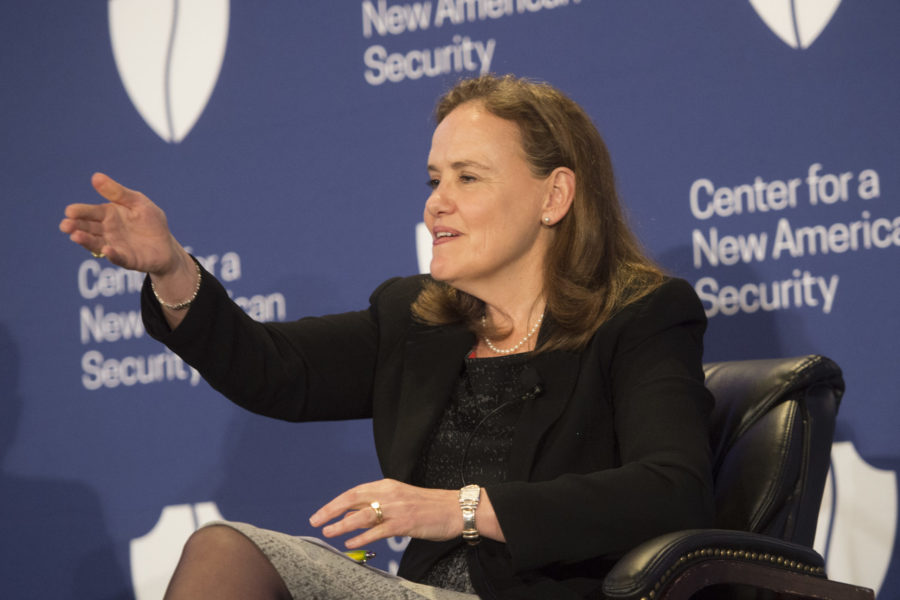As the Pentagon looks to deter China in the coming years, officials need to find ways to make new technologies and existing systems work together to build capacity, former Defense Department policy chief Michèle Flournoy said Oct. 6.
In particular, Flournoy—a defense analyst who served as undersecretary of defense for policy from 2009 to 2012—touted the concept of manned-unmanned teaming as especially promising during a livestreamed fireside chat with the Atlantic Council about deterring China through the 2020s.
Manned-unmanned teaming is a technology area the Air Force has been pursuing for several years, a pursuit that’s heated up recently as Secretary Frank Kendall has pushed for cheap, autonomous drones to fly alongside fighters, an effort that has been dubbed collaborative combat aircraft.
Chief of Staff Gen. Charles Q. Brown Jr. has also said such drones, which could carry sensors, weapons, and pods to disaggregate and complement manned platforms’ capabilities, aren’t intended to only pair with the Air Force’s Next Generation Air Dominance fighter.
“We want to not constrain ourselves and say it’s tied to NGAD,” Brown said this August, but “how do we look at it from a broader perspective?” Other potential platforms include the F-35, F-15EX, E-7, and KC-46.
Such an approach would seemingly complement an issue Flournoy identified in her remarks—the need to mesh rapidly developed tech with already-fielded systems.
“A lot of people … kind of create a false trade-off, I think, between, we’re either going to divest of all of our legacy systems and create all these new capabilities,” Flournoy said, or just keep only legacy systems. “And the answer is that’s wrong. We are going to have a largely legacy force for the foreseeable future. That’s just a fact.”
Working within that reality, the Pentagon must find a way to “marry” those legacy systems “with new technologies and capabilities—some defense, some commercial—that are emerging that give them meaningfully different capabilities,” Flournoy said.
Some of those new technologies are “very mature” and even available “off the shelf,” Flournoy added, pointing to “particularly unmanned systems that can be operated by a manned platform.”
That description seems to mirror the vision Kendall has laid out for collaborative combat aircraft in which a pilot has multiple unmanned “wingmen” and can “be essentially calling plays and employing uncrewed combat aircraft as wingmen in tactically optimized ways,” he has said.
Particularly within the context of deterring China, Flournoy said manned-unmanned teaming could be critical because in “trying to deter or fight in China’s backyard … they will always have a quantitative advantage. Lower-cost drones to pair with manned platforms could close that capacity gap and give the U.S. “greater mass in the near term,” Flournoy said.
The Air Force is aggressively pursuing such a concept—Kendall has said he wants to hold a competition for the CCA program in 2024—and that approach could be needed, depending on China’s strategic considerations for attempting to invade Taiwan, a scenario that could very likely draw the U.S. into a conflict.
Because so much of the Pentagon’s modernization plans focus on fielding capabilities in the 2030s, Chinese president Xi Jinping may decide that if a military confrontation is needed, “maybe there’s a window where it’s better to use force before the Americans and their allies have fully set the region with the right posture and capability mix,” Flournoy said. “Because that would [mean China will] have a better chance of success sooner than later.”
Such a scenario in the mid to late 2020s is a key issue the Pentagon needs to do a better job of preparing for, Flournoy said, starting with putting someone in charge of considering the medium-term outlook.
“The service chiefs have the 2030-and-beyond perspective. The [combatant commanders] have the next-two-or-three-years perspective,” Flournoy said. “There’s no one focused on this problem every day, accountable to the Secretary every day, for making progress in this area. So authorize someone to be in charge.”
In considering that mid-range timeframe, Defense Department leaders need to take an “Apollo 13” approach, Flournoy added—making the best use possible of what they have instead of waiting for future capabilities so that they can “meaningfully enhance deterrence, so that we undermine Xi’s confidence in using force and we avoid the conflict if at all possible.”
There has been plenty of speculation as to whether Xi and China’s calculus for a potential Taiwan invasion has changed after seeing Russia struggle to make gains after its invasion of Ukraine while the U.S. and its partners have banded together. But Flournoy warned against assuming Chinese forces would struggle as much as Russia’s have.
“There’s a temptation because the Chinese military is untested from a combat perspective, to sort of say, well, maybe they’re just as feckless as the Russian forces were. I think that would be a mistake,” Flournoy said. “You know, I don’t think we should say they’re 10 feet tall, [and] they have their own problems and their own challenges, and they are untested. But they’ve also made tremendous strides in the professionalization of the force, particularly over the last decade, and I don’t think we should underestimate them.”
